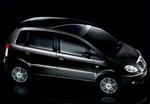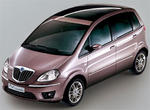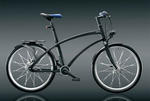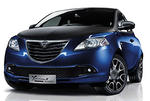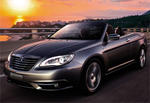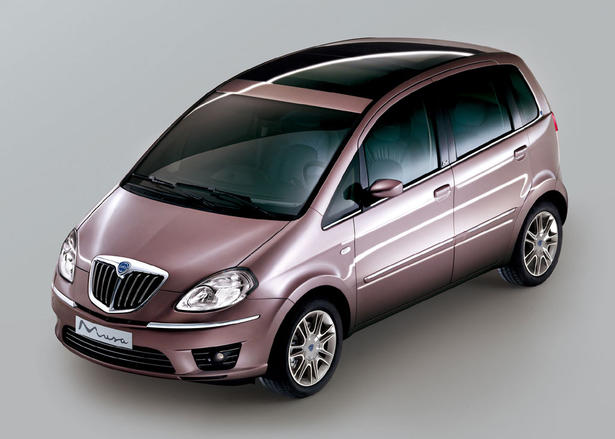
Lancia released a detailed description of the 2008 Lancia Musa and a large photo gallery. The 2008 Lancia Musa wants to follow the foot steps of the previous model which was the best selling people-mover in Italy in 2006 and 2007.
Lancia Press Release:
New Lancia Musa
The model in brief
The new Musa went on the market this month, the heir to a winning model which in three years on the market has not only achieved all its most ambitious goals, but has far exceeded all expectations (in 2006 and 2007 it was the
best-selling compact people-mover in Italy).
Today the new Musa takes up the challenge, playing the same trump card as the previous model, and bringing the values of Italian hospitality to the world of the car. Its line and contents recreate an atmosphere that is typically Italian, a mixture of elegance and informality, attention and relaxation, luxury and naturalness that puts people at their ease. In today’s European compact market, the new Musa is the Italian alternative, inspired by concepts of good taste, warmth and generosity.
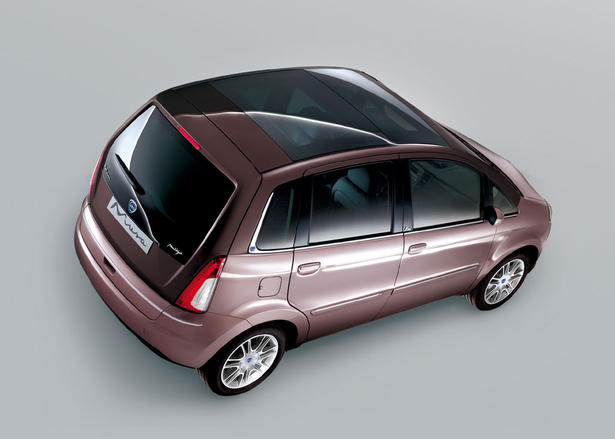
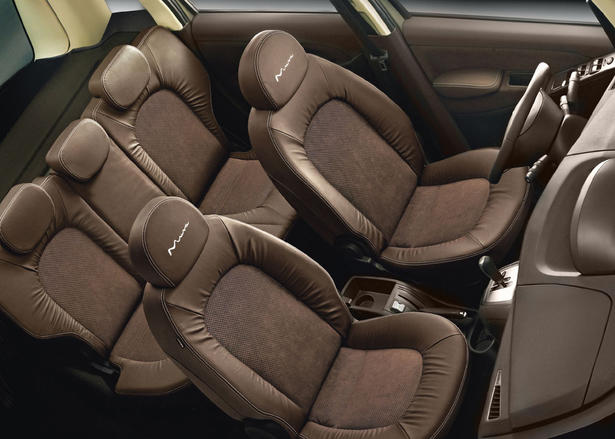
Designed by the Lancia Style Centre, the new Musa remains a compact, as its dimensions show: it is little more than four metres long, 1.70 metres wide, 1.66 metres tall and has a wheelbase of 2.51 metres. The new model conveys a greater ‘size impression’, as a result of several styling changes that blend the elegance of the shape with the practicality and interior space. For example, a number of chrome details on the front underline the model’s dynamic look while they hint at the design of future Lancia cars. The new Lancia logo stands out at the centre of the elegant chrome grille, a sign of the past reinterpreted in a modern key to represent
a brand that is projected towards the challenges of the future but also proud of its own historical identity.
The designers have also succeeded in remodelling the rear of the car, while maintaining the harmony and stylistic consistency of the front. The generous tailgate is now larger than on the previous model, guaranteeing more space and better access so that the luggage compartment can be exploited better: luggage capacity has been increased by 70 litres to 390 litres (460 litres when the sliding
seats are fully forward, a record for this class), and the loading floor has been lowered by 4 cm to make it easier to stow bags and cases. In other words the new Musa has all the roominess of a flagship.
And finally, the side view is elegant and uncluttered, with two profiles that run parallel to the waistline, accentuating the car’s dynamic look. The higher of the two is highlighted by a chrome moulding that matches the new alloy wheels. The effect is enhanced by the Musa logo, which recalls a chaise longue, a symbol of comfort and relaxation, positioned at the base of the pillar between the two doors, and the Lancia logo set in the corner of the third side window.
The new Musa is the first people-mover in its category to mount technological rear lights fitted with LEDs, which provide greater luminous intensity and enhanced safety compared to conventional lights, as well as unique styling.
The same stylistic consistency is evident inside the car. The interior of the new Musa appeals to the emotions; a real living-space but also a light-filled, practical, modern passenger compartment that ensures comfortable driving at all times for driver and passengers, thanks also to the versatile seats which can be adjusted to take numerous positions. These sensations are also the result of the care that has gone into every detail, the luxurious materials used and the creation of refined, elegant matching colour combinations between the bodywork and the interior upholstery, which is available in two specifications, one warmer and welcoming, the other colder and technological; we should also mention the novelty of a choice between the original brown facia and new dark blue.
The ergonomic seats combine with the raised driving seat and the ergonomically arranged controls to make the interior more enjoyable and easy to control. The whole effect is made even more interesting by the adoption of numerous exclusive features typical of Lancia: from the panoramic opening sunroof, to dual-zone climate control, Bose® Sound System, the DFN gearbox and the ‘Blue&Me’® system which allows you to telephone and to listen to music as you drive, easily and simply, thanks to the hands-free system with voice recognition, and to Bluetooth® technology (the device also incorporates a USB port positioned on the tunnel, to which all types of digital devices can be connected). And finally, to maximise well-being on board, the new Musa adopts the best soundproofing equipment available today; the new sound-absorbent ceiling, which is made of an innovative polyester-based material, attenuates the sound inside the passenger compartment by approximately 2 dB, an improvement that is perceptible to occupants.
The new Musa is elegant, practical and lavishly equipped, and guarantees predictable dynamic behaviour at all times and an enjoyable drive, the result of the performance delivered by the five engines in the range, all of which are elastic, sturdy and eco-friendly. There are three Multijet turbodiesels: the 1.9 delivering 100 bhp, and two 1.3 units delivering 70 or 90 bhp (which can be combined with the DFN gearbox, while the 90 bhp version offers the option of a particulate trap). There are also two petrol engines: the sparkling 1.4 Fire delivering 77 or 95 bhp (the latter also with the DFN gearbox). The engines on the new Musa are offered with a choice of two gearboxes: a five speed mechanical unit and the popular DFN, a robotised device that functions in sequential or automatic mode. Whatever you choose, the new Musa is just as enjoyable in town traffic or on long or short journeys out of town.
The new Musa comes in a broad, comprehensive range that caters for customers with very different tastes and requirements. The new model range offers over 80 possible combinations obtained by mixing 5 different outfits (Argento, and Oro and Platino, both available in two different tones, warm or cold), 14 bodywork colours (10 of which are new) and 4 new ‘b-colore’ two-tone liveries, producing the broadest range in this segment. The design of the interior combined the choice of different colours with that of different materials, including technical fabrics, quality leather and elegant Alcantara®. Chrome and satin-effect details enhance the lines and shapes of the interior.
Revamped styling that is elegant and practical
The styling of the new Musa is made more attractive and modern by a number of elements that reflect the latest market trends. And this aesthetic refinement has created a greater ‘size impression’ of the car, which will certainly be appreciated by the target clientele that demands not only elegant, refined lines, but practicality and space too.
Designed by the Lancia Style Centre, the model incorporates strong, substantial references to classic Lancia stylistic elements, re-read in a modern key to reflect the evolution of styling in premium segment vehicles. A number of chrome elements have been added to the front, to underline a new styling imprint which accentuates the model’s dynamic look while it hints at the design of future Lancia’s. The new Lancia logo stands out at the centre of the elegant grille, a sign of the past reinterpreted in a modern key to represent a brand that is projected towards the challenges of the future but also proud of its historical identity.
The same harmony and stylistic consistency are found in the entirely remodelled rear end. The generous tailgate is in perfect harmony with the new stylistic imprint of the front, and contains two significant novelties. To start with, luggage compartment capacity has been increased by 70 litres to 390 litres, and becomes 460 litres when the sliding seats are fully forward, a loading capacity that puts the Musa at the top of its class. And the loading floor has been lowered by 4 cm to make it easier to stow bags and cases; in other words, more space and better access so that it can be exploited better.
Another feature of the rear end of the new Musa are the lovely, technological rear lights; long, thin vertical elements, fitted with LEDs, which provide greater luminous intensity and greater safety than conventional lights, as well as their unique styling. The new Musa is the first people-mover in its category to adopt this technology, which is usually only found on up-market cars.
The surface of the sides is elegant and sleek. Two profiles run parallel to the waistline, creating a faceted effect that accentuates the car’s dynamic look. The higher of the two is underlined and highlighted by the new chrome moulding that matches the new alloy wheels. The effect is enhanced by the Musa logo, which recalls a chaise longue, the symbol of comfort and relaxation, positioned at the base of the pillar between the two doors, and the Lancia logo set in the corner of the third side window. The rounded lines and lack of sharp edges emphasise the welcoming, protective character of the passenger compartment, a ‘treasure-chest’ that promises great safety and the utmost comfort in small dimensions: it is little more than four metres long, 1.70 metres wide, 1.66 metres tall and has a wheelbase of 2.51 metres. Although the new Musa has grown in length, it is still a compact model, on the outside, but offers all the roominess of a flagship on the inside. The balance between the bodywork, the large side measurements and the large sunroof is the key to the luminous, relaxing interior.
In line with the unmistakable Lancia style of recent years, the new Musa welcomes passengers and driver in an environment that combines emotion with practicality, thanks to the versatile seats, which can be placed in different positions. The rear seat has an equipped armrest, and slides to expand the luggage compartment, or to give rear passengers more legroom. It also splits 60/40 and reclines; the squab of the front passenger seat, on the other hand, folds down into a practical table. Traditional Lancia elegance and refinement is reflected in the great care that has gone into every detail and the refined colour combinations between the bodywork and interior upholstery, which is available in two tones, one warmer and welcoming, and the other colder and technological; and there is now a choice between a dark blue facia and the original brown.
The customer can have his New Musa ‘made to measure’, like a tailored suit. There are over 80 possible alternatives that come from combining 5 different interior outfits (Argento, and Oro and Platino both available in a warm and a cold shade), 14 bodywork shades (10 of which are new) and 4 new ‘b-colore’ liveries: it is the broadest range of alternatives in this segment. Colour has always been much more than a question of aesthetics for Lancia; it is an integral part of a product philosophy whose main elements include elegance, glamour, personality, verve, styling and an almost endless choice of ways to customise the car.
And finally, in the interior, analysis of the colours is associated with that of the trim, with a choice of technical fabrics, luxury leather and elegant Alcantara®. Chrome and satin-effect elements set off the lines and forms of the interior. Lancia maintains its traditional beautifully crafted interiors, but it now combines original new trim and colours to reveal a modern reinterpretation of one of its traditional values.
Cutting-edge technology for well-being on board
Travelling in the new Musa is always an exciting experience, thanks to the airy interior, the pleasant surfaces and the wrapround comfort of its ergonomic seats. The raised driving position and ergonomically arranged controls make a living space that is easy to dominate all the more enjoyable. The whole effect is made even more interesting by the adoption of numerous exclusive features typical of Lancia: from the panoramic sunroof to the dual-zone climate system, Bose® Sound System and DFN gearbox.
And finally, to maximise well-being on board, the new Musa adopts the best equipment available today in terms of soundproofing; the new sound-absorbent ceiling, which is made of an innovative polyester-based material, attenuates the sound inside the passenger compartment by approximately 2 dB, an improvement that is perceptible to occupants.
Dominating space and the road
The new Musa is a car in which to relax and travel safely. Its interior was designed to accommodate passengers in the best possible way: as you discover when you get in, sit down, adjust the seats and open and close the large sunroof. The new model meets the demand for roominess from a population whose needs are growing in step with its height: the passenger room coefficient is 99.5%. At the front, occupants varying in height from 1.50 to approximately 2 metres will find the adjustment that suits them. And even when the driver is very tall, a passenger of a similar height seated behind him will still be very comfortable. Roominess at shoulder height is excellent in the front and rear, and by adjusting the sliding seats, the luggage compartment capacity can be increased to 460 litres. The interior roominess is excellent for this segment, both in absolute terms and in relation to the dimensions of the car. But, for Lancia, the ‘quality of the welcome’ is even more important than the physical measurements. The airy environment creates a new dimension to life in the car, and the pleasure of being on board. The car’s versatility offers plenty of space, but above all it offers space where you need it, letting you choose how to organise the space and which of the 32 possible configurations to adopt.
Where ‘dominion of the road’, is concerned, the new Musa was designed and built to meet motorists’ desires and their new demand for mobility. The driving set-up is extremely modern: seats are raised for better control of the road, a sensation that is helped by the generous glazing. The gearshift is positioned at the centre of the facia, the steering wheel adjusts for height and rake, and the driving seat also adjusts for height. The instrumentation at the centre of the facia is easier to read because of the optimal distance of the digits and the linear graphics. All the (analogue) instruments are rear-lit with an orange light, and the ergonomic driving position guarantees excellent dynamic responses.
The suspension on the new Musa was designed to guarantee control and comfort: independent wheel MacPherson system at the front, and interconnected wheels with a torsion beam at the rear. The combination of the two systems provides handling worthy of an up-market model.
The sense of protectiveness conveyed by the car is not only the psychological effect of the care, elegance and ‘domestic’ familiarity of the furnishings: it is also the result of an objective element: the fact that the car meets precise safety criteria.
The panoramic sunroof
The new Musa is a sunny car: in addition to the generous glazed surfaces, it also offers a large opening sunroof, made of two glass panels (one of which opens) and two sunblinds that slide independently towards the rear of the car. When both blinds are open, the transparent surface accounts for 70% of the roof.
This latest generation device opens and closes very rapidly: the front glazed panel opens in just seven seconds. That is not all: it also changes your relationship with the environment. The alternative is not just between an open roof or a closed roof: the Musa offers passengers the option of being perfectly protected from the elements but with the interior bathed in light through the ‘window on the sky’. But the front panel can also be opened to an intermediate position on its aluminium runners; you only have to release the control button to stop the movement in the desired position. And finally, the opening mechanism incorporates a safety system that reverses the movement of the glass if it encounters an obstacle.
Dual zone climate system
The climate inside the car is one of the main factors of comfort during a journey, and it is also important for preventive safety, because temperature, humidity and ventilation affect the driver’s well-being and therefore his attention level. The system on the new Musa incorporates a highly sensitive automatic control unit that adjusts the temperature, air flow, the air distribution between driver and passenger, and activation of the compressor and the recirculation function. It is a ‘dual-zone’ system, capable of supplying a different temperature on the left and the right side of the passenger compartment.
The new Musa also adopts an ‘equivalent temperature’ climate control strategy. A number of sensors assess the sensation of thermal well-being perceived by the passenger in relation to the set temperature. This makes it possible to keep the interior climate constant even when outdoor conditions change.
The customer can modify the temperature gradually, by half a degree at a time, until he reaches optimal climatic comfort. The knob allows a range of 16°C, with a maximum difference between the left and right of the car of 7°C. The system is entirely automatic, but manual selections always take precedence over the automated settings, and it is always possible to deactivate the system entirely.
The ‘dual-zone’ climate system incorporates a device known as the Air Quality Sensor (AQS) which verifies the quality of the air. The sensor automatically triggers the recirculation function and blocks out the outdoor air when the car is travelling in an area with a high level of smog.
The Bose® Sound System
Any welcome would be incomplete without the pleasure that comes from music. And on the new Musa, the Bose® Sound System revives the emotions of a concert hall, with a sound that envelopes all occupants completely.
The system was developed by the American company that is leader of the acoustic Hi-Fi market, and it guarantees realistic reproduction with crystal clear high notes and full rich basses. The incredible sense of depth experienced by passengers is the result of complex acoustic planning, which designed the passenger compartment of the car and the audio system together.
The Bose® Hi-Fi Sound System includes an audio power amplifier with 6 independent channels. An equaliser automatically guarantees perfect electronic balancing of the output on all frequencies, as well as great balance and clear tones throughout the audio range. A total of 7 diffusers are built into the car: two 165 mm broadband speakers in the front doors with 50 mm tweeters, two 150 mm mid-woofers in the rear sides and a Bass-reflex dual-coil subwoofer with a diameter of 130 mm in the rear, plus two tweeters in the front pillars.
Besides the Bose® Sound System, the new Musa offers a choice of two more audio systems, built into the design of the dashboard. As an alternative to the Bose® system they can both adopt six speakers, with a power output of 4x30 Watt, and they incorporate RDS (Radio Data System) and the TA function (traffic news). One offers a CD player, while the other also reads MP3 files.
All the audio systems feature automatic volume adjustment according to the vehicle speed, and can be linked to the hands-free kit of the GSM telephone. They are also protected against theft thanks to a communication protocol with the electronic unit that manages the electrical system (body computer). When the ignition is turned on, the body computer checks the radio code, and only activates it if the numerical sequence is correct. Stealing it is a waste of time as the system cannot be used on another car.
The customer can also install a CD-changer for up to ten CDs on his new Musa, which can be activated by the steering wheel controls.
The DFN gearbox
The DFN gearbox is a robotised gearbox that controls transmission automatically, and is available with the 1.4 16v and 1.3 Multijet 16v engines. The device makes driving in town traffic particularly convenient due to the automatic mode, perhaps after having enjoyed a dynamic, sporty driving style with the manual transmission.
The DFN gearbox automates the clutch and gear lever controls by means of an electrohydraulic servo, but maintains all the advantages of a dry clutch and a mechanical gearbox (weight, sturdiness and reliability, low energy consumption).
There are two operating modes: semiautomatic (manual) and automatic.
The first is more similar to manual operation, and gears are engaged using the joystick on the tunnel. Because there is no clutch pedal, the device is controlled simply by moving the lever: forward to change up (towards the ‘+’ symbol), back to change down (towards the ‘-’ symbol). A simple push is sufficient to ensure the transmission makes a fast, accurate gear change.
The second mode offers two settings: Normal and Economy. The Normal setting provides outstanding driving comfort, with brilliant acceleration and gear changes in all conditions. The Economy setting, on the other hand, is used to reduce fuel consumption, while still maintaining outstanding handling and comfort. With both settings, the system extends the rev speed to the higher ratio reached when the engine delivers maximum torque or power. And in automatic mode, the system recognises the road gradient and modifies the gear shift point to ensure the best possible compromise between the driver’s needs, ground conditions and the vehicle situation (speed and engine rpm).
The DFN has another advantage over conventional manual and automatic transmissions: it can ‘interpret’ the driver’s requests and adapt to his driving style. To do so, it examines the mapping of the pedal position and the engine revs (interpreted as requests for power). And to guarantee safety and prevent incorrect gear engagement, the system engages neutral automatically when a door is open with the engine running. The device also prevents errors that might damage the engine or gearbox, by notifying the driver of emergency situations or incorrect manoeuvres with warning lights and beeps.
In automatic mode, the robotised electronic management of the DFN gearbox allows the gear changes to be set when the engine reaches its maximum efficiency. This exploits the power and torque of the 1.4 16v and 1.3 Multijet engines in full with a net improvement in acceleration compared to a manual gearbox. In automatic mode, with the Economy key engaged, the new Musa consumes less than with a manual gearbox: on the combined cycle, the 1.3 Multijet engine returns consumption of 4.6 l/100 km compared to 4.7 l/100 km with a manual gearbox; for the 1.4 16v engine, the figures are 6.4 l/100 km compared to 6.6 l/100 km.
The engineers have succeeded in calibrating a gear change management system that does not detract from performance, or from the enjoyment of driving the car, but does lower consumption. And all these technological features are available at a price that is significantly lower than that of a conventional automatic transmission.
The ‘Blue&Me’® system
The new Musa can be equipped with the innovative ‘Blue&Me®’ system, based on the Windows Mobile technology, developed by Fiat Group Automobiles and Microsoft, which changes the communication, information and entertainment paradigms in the car, improving comfort and the quality of life on board.
The device is easy to use and Bluetooth® technology allows you to make and receive telephone calls and listen to music simply and safely as you drive, communicating with the outside world from the car via your own personal devices such as cell phones and PDAs.
Other, more evolved devices will be available later, giving access to the many novelties that technology will make available in the coming years: from complete multimedia operation to satellite navigation, and a set of services will also be offered to make using the car more convenient, safer and easier.
The Blue&Me® device incorporates a refined hands-free system with voice recognition, which guarantees maximum driving safety in all conditions and in full respect for the law, because the driver can use it without taking his hands off the wheel. The system allows a customer with a Bluetooth® cell phone to use it without taking it out of his pocket or bag, and it automatically lowers the radio volume (if this is on) and transmits the interlocutor’s voice through the stereo speakers. What is more, the system is compatible with all the cell phones on the market today, and may be upgraded to comply with new standards and future telephones.
The Blue&Me® device is built into the car and the control keys are on the steering wheel, so that you can search for a number in the phonebook by scrolling through the display on the instrument panel, or ‘mute’ the communication for a more confidential conversation.
The main features include the fact that a cell phone only has to be registered once on the system, and the whole phonebook can be transferred to the car, being automatically updated every time the system recognises the cell phone.
Privacy is guaranteed because access to the phonebook is only granted when the telephone registered with the system is present. The display shows the number or name of the person calling if this is recognised by the phonebook, and it is possible to formulate a number ‘vocally’ by dictating it digit by digit, or to call a person by saying his or her name, if it is memorised.
And thanks to an advanced voice recognition process, no voice learning process is necessary. The device is able to memorise up to 5 cell phones, thus granting several users of a single car immediate use of the hands-free system; the programming can obviously be modified whenever necessary. And with the hands-free system with voice recognition, it is even possible to reproduce personal telephone call tones through the car radio.
This is the hands-free system with voice recognition, but there are other features to the innovative Blue&Me® system: it allows you to listen to your favourite music recorded on a cell phone, new smart phone, an MP3 player or a USB pen drive. This is made possible by the presence of a USB port on the tunnel, which can connect to any digital device with a similar connection. This allows musical audio files (MP3, WMA and WAV) to be played through the stereo system. And because all the information is visible on the instrument panel display, the user can browse the system archive (divided by type, album, artist, etc.) either vocally or using the steering wheel controls, and select the music he wishes.
Generous engines for an enjoyable drive
The engines in the range guarantee a perfect balance between performance, consumption and respect for the environment. The range comprises three Multijet turbodiesels: the round, elastic 1.9 delivering 100 bhp, and two 1.3 units delivering 70 or 90 bhp, which are perfect in town when combined with the sequential robotised DFN gearbox (the 90 bhp version is available with the option of a particulate trap). There are also two petrol engines: a 1.4 delivering 77 bhp, and a 95 bhp 1.4 Fire (also available with the DFN gearbox).
The 100 bhp 1.9 Multijet
This is a 1.9 Multijet engine (Common rail with multiple injection) with 4 cylinders in line, bore of 82 mm and stroke of 90.4 mm. There are two valves per cylinder, activated directly by an overhead camshaft.
The Common Rail system adopted by the 100 bhp 1.9 Multijet incorporates two automatic strategies to control calibration and balancing of the injected diesel fuel, making for quieter operation and reducing vibration. The combustion chamber has also been optimised to improve the thermodynamic efficiency, reducing the compression ratio to 18:1.
Turbocharging on the engine is a fixed geometry turbo fitted with an electronic Waste Gate valve, which improves power delivery while guaranteeing high torque even at low engine speeds. Suffice it to say that 90% of peak torque is available between 1750 and 3250 rpm, and this translates into extremely enjoyable driving and sparkling performance.
The 1.9 Multijet features an extremely quiet heating-up stage and excellent power delivery (100 bhp at 4000 rpm) combined with generous torque (26.4 kgm at 1750 rpm). With this engine, the new Musa reaches a top speed of 179 km/h, accelerating from 0 to 100 km/h in 11.5 seconds, and from 0 to 1000 m in just 33 seconds. Sparkling performance, but low consumption: 6.5 l/100 km in the urban cycle, 4.4 l/100 km out of town and 5.2 l/100 km on the combined cycle.
Like the 1.3 Multijet, the 1.9 Multijet belongs to the family of second generation Common rail engines. They share the same principles as the original Common rail engines: high injection pressure and electronic injector control. But with an additional feature: the number of injections increases during each engine cycle. Inside the cylinder, the quantity of diesel fuel burned remains the same, but it is broken down into several parts for more gradual, more complete combustion. The secret of the Multijet lies in the electronic control unit that governs the opening and closing of the injectors, which can make them perform a series of very close injections.
There are three main advantages over the first generation Common rails: quieter operation, lower emissions and boosted performance.
The 90 bhp and 70 bhp 1.3 Multijet 16v
The new Musa range would not be complete without the 1.3 16v Multijet engine, the smallest and most advanced second generation direct injection Common rail diesel unit, now available in two power levels: 90 bhp and 70 bhp.
Thanks to a variable geometry turbo the first version Multijet delivers a maximum of 90 bhp (66 kW) at 4000 rpm and torque of 200 Nm (20.4 kgm) at 1750 rpm. That is not all. With the 90 bhp 1.3 Multijet, the new Musa guarantees excellent performance: it accelerates from 0 to 100 km/h in 12.5 seconds, from 0 to 1000 m in 34 seconds and has a top speed of 173 km/h. Fuel consumption is 6.0 l/100 km in the urban cycle, 4.0 l/100 km out of town and 4.7 l/100 km in the combined cycle
A number of changes have been made to the new engine, in addition to the different turbo (the turbo on the 70 bhp 1.3 Multijet is of fixed geometry type). The combustion system has been modified, increasing the permeability of the inlet and exhaust manifolds, reducing the turbulence in the combustion chamber and consequently modifying the geometry and the compression ratio from 18:1 to 17.6:1. The emissions control system includes an EGR valve with electrical activation, managed directly by the engine control system, a heat exchanger to cool the recirculating exhaust gases (EGR) and a close coupled catalytic converter. This guarantees that the car meets the EEC STAGE 4 emissions targets.
Performance is also excellent from the 70 bhp 1.3 Multijet: 70 bhp at 4000 rpm (51 kW) and peak torque of 180 Nm at just 1750 rpm. Equipped with this engine the Musa has a top speed of 159 km/h, accelerates from 0 to 100 km/h in 15.4 seconds, and from 0 to 1000 m in 36.6 seconds. Fuel consumption is also among the best in this segment: 6.0 l/100 km in the urban cycle, 4.2 l/100 km out of town and 4.9 l/100 km in the combined cycle.
Those are the differences between the 70 bhp and 90 bhp versions; however they both share the same architecture. They are both straight-4 engines with a capacity of 1248 cc, a bore of 69.6 mm and a ‘long’ stroke of 82 mm. There are four valves per cylinder, activated directly by a twin overhead camshaft. That is not all. The 1.3 Multijet 16v is a miniature masterpiece of technology: ‘dressed’ with all its accessories, it weighs just 130 kg, it is small, less than 50 cm long and 65 cm tall, and the component layout was designed to take up as little space as possible.
Designed to respect criteria of maximum rationality, efficiency and reliability, the engine guarantees excellent efficiency and is practically ‘for life’: it was designed to travel 250,000 km without needing any maintenance to the mechanicals. Oil change intervals have also been extended, from 20,000 to 30,000 km, and the 1.3 Multijet 16v uses a low viscosity oil, which means fuel economy and more respect for the environment.
The compact, sophisticated 1.3 Multijet 16v (both 70 bhp and 90 bhp) represents a technological leap forward which, for the customer, translates into lower consumption and emissions, without even taking into consideration the reduction in noise (due to the multiple injections), the increase in comfort (fewer alternating masses means less vibration), the smooth, responsive steering (due to the extremely smooth torque delivery, which in turn is guaranteed by the improved combustion control), the elasticity and prompt response of a diesel that resembles a petrol engine for the vast excursion in the number of revs (for example, you are no longer aware of the fuel ‘cut-out’ just above 4000 rpm), or the ecological characteristics that enhance the diesel’s main environmental credentials (consumption) while minimising its main defect (particulate emissions).
The 77 bhp and 95 bhp 1.4 16v Fire
The new engine has a capacity of 1368 cc, and 4 cylinders in line, bore of 72 mm, stroke of 84 mm, and two valves per cylinder (four on the 95 bhp version). The engine was developed paying particular attention to performance and to fuel economy, two areas in which the new Musa leads its class. The merit goes to the volumetric efficiency which has been optimised all through the operating range, thanks to a specific fluid-dynamic calibration of the entire intake system and of the timing.
There is a choice of two versions: the first delivers 57 km (77 bhp) at 6000 rpm, and peak torque of 11.7 kgm at 3000 rpm. It has a top speed of 163 km/h and accelerates from 0 to 100 km/h in 13.5 seconds. Consumption is particularly low: 7.9 l/100 km in the urban cycle, 5.2 l/100 km out of town, and 6.2 l/100 km in the combined cycle.
The new Musa can also be equipped with another 1.4 Fire engine, which delivers 70 kW (95 bhp) at 5800 rpm, and peak torque of 13 kgm at 4500 rpm. With this engine the Lancia Musa has a top speed above 175 km/h, accelerates from 0 to 100 km/h in 11.5 seconds and from 0 to 1000 m in 33 seconds. But consumption remains good: 8.7 l/100 km in the urban cycle, 5.4 l/100 km out of town, and 6.6 l/100 km in the combined cycle. A sparkling yet parsimonious engine that delivers excellent performance, achieved thanks also to the electronic throttle valve control system known as ‘drive by wire’. The engine is also completely compatible with devices such as ESP and Cruise Control. The 1.4 16v Fire engine delivers high torque values at low speeds, characteristics that make it possible to limit fuel consumption. Emissions respect Euro 4 legislation, thanks to the catalytic converter in the engine bay, which reaches very high temperatures faster, thus reducing emissions even while the engine is warming up. To minimise the environmental impact, the engine also incorporates a returnless fuel supply system, which eliminates fuel recirculation within the tank, and reduces vapour formation.
Exciting, sparing on fuel and clean: to these characteristics, the 95 bhp 1.4 16v Fire engine adds excellent acoustic comfort. To reduce the vibration transmitted from the engine to the bodyshell to a minimum, a barycentre engine support system has been adopted, so as to obtain reaction forces with a neutral link.
A broad, comprehensive range
The new Musa comes in a broad, comprehensive range that caters for customers with very different tastes and requirements. There are five different interior outfits: Argento, Oro and Platino (the latter two available in two shades of warm or cold colours). Whatever the level of customisation, the new Musa is always fascinating and original, never losing sight of world famous Italian taste.
The standard and optional equipment varies to some extent on the different markets. In general, the Argento version offers airbags for the driver and front passenger as standard equipment, with a manual climate system and wiring for a radio. Technical fabrics transform the passenger compartment into a pleasant living environment.
The second specification level, known as Oro, adds 15” alloy wheels (depending on the market) with a new design, and exterior chromed trims on the side windows. Other features include curtain-bags, three rear head-restraints, sliding, folding split rear seats and electric wing mirrors. The customer can also choose between two versions of the Oro specification, which differ for the fabric and shade of the interior upholstery: one offers technological ‘Airtex’ fabric with cold tones, while fashionable pinstriped fabric and warmer tones characterise the other.
The new Musa Platino offers a lavish array of equipment ranging from the panoramic electric sunroof to a radio-CD player with steering wheel mounted controls. New 15” alloy wheels, Privacy tinted windows, a leather steering wheel and gear lever gaiter with contrasting stitching, foglights, a dual-zone climate system, ESP, sidebags and armrests on the front seats complete the generous array of equipment available. This specification also offers two interior environments that differ for the shade of the upholstery, with warm (leather/Alcantara® Starlite in two different shades, Chocolate and Turtledove), or cold tones (blue and grey leather/Alcantara® Starlite).





